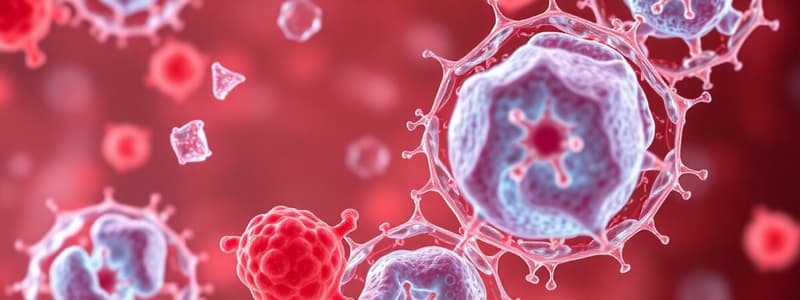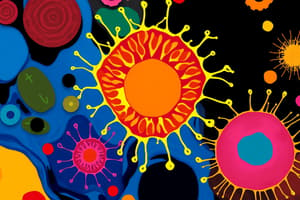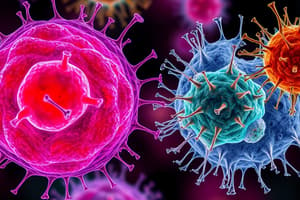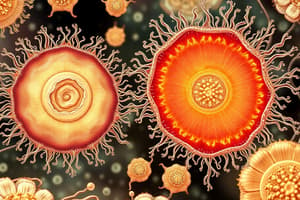Podcast
Questions and Answers
Which organelle is responsible for ATP production and has a double-membrane system?
Which organelle is responsible for ATP production and has a double-membrane system?
- Chloroplast
- Lysosome
- Mitochondria (correct)
- Nucleus
Chloroplasts are found in both plant and animal cells.
Chloroplasts are found in both plant and animal cells.
False (B)
What is the primary function of lysosomes?
What is the primary function of lysosomes?
Digest and break down waste materials and cellular debris
The ________ system consists of a double membrane and is responsible for producing ATP.
The ________ system consists of a double membrane and is responsible for producing ATP.
Which structure helps maintain cell shape and enables organelle movement within cells?
Which structure helps maintain cell shape and enables organelle movement within cells?
Match the following organelles with their primary functions:
Match the following organelles with their primary functions:
The thylakoid membranes in chloroplasts capture solar energy.
The thylakoid membranes in chloroplasts capture solar energy.
What type of protein attaches to microtubules and assists in cellular movement?
What type of protein attaches to microtubules and assists in cellular movement?
What are the primary components that make up centrioles?
What are the primary components that make up centrioles?
Kinesin and dynein are types of actin filaments.
Kinesin and dynein are types of actin filaments.
What is the role of myosin in cellular movement?
What is the role of myosin in cellular movement?
The ______ is responsible for transporting vesicles from the Golgi apparatus to their final destination.
The ______ is responsible for transporting vesicles from the Golgi apparatus to their final destination.
Match each structure with its primary function:
Match each structure with its primary function:
Which of the following is NOT a function of actin filaments?
Which of the following is NOT a function of actin filaments?
Centrioles are present in both animal and plant cells.
Centrioles are present in both animal and plant cells.
What cellular structure interacts with actin for muscle contraction?
What cellular structure interacts with actin for muscle contraction?
What is a primary function of the Rough Endoplasmic Reticulum (Rough ER)?
What is a primary function of the Rough Endoplasmic Reticulum (Rough ER)?
The Smooth Endoplasmic Reticulum (Smooth ER) is primarily involved in protein synthesis.
The Smooth Endoplasmic Reticulum (Smooth ER) is primarily involved in protein synthesis.
What role does the Golgi Apparatus serve in a cell?
What role does the Golgi Apparatus serve in a cell?
The primary function of lysosomes is the ______ of cellular waste and macromolecules.
The primary function of lysosomes is the ______ of cellular waste and macromolecules.
Which of the following structures is primarily responsible for energy production in the cell?
Which of the following structures is primarily responsible for energy production in the cell?
Mitochondria have a double membrane structure.
Mitochondria have a double membrane structure.
How does the Smooth ER contribute to detoxification?
How does the Smooth ER contribute to detoxification?
The ______ is a dense mass of material in the nucleus that synthesizes ribosomes.
The ______ is a dense mass of material in the nucleus that synthesizes ribosomes.
Match the cellular organelle with its function:
Match the cellular organelle with its function:
Which organelle's primary function is associated with the storage and processing of genetic information?
Which organelle's primary function is associated with the storage and processing of genetic information?
Flashcards
Lysosomes
Lysosomes
Membranous sacs that move through the cytoplasm.
Peroxisomes
Peroxisomes
Membranous sacs that move through the cytoplasm.
Mitochondria
Mitochondria
ATP-producing powerhouses, essential for energy reactions in cells; contain inner and outer membranes.
Chloroplasts
Chloroplasts
Signup and view all the flashcards
Cytoskeletal elements
Cytoskeletal elements
Signup and view all the flashcards
Microtubules
Microtubules
Signup and view all the flashcards
Intermediate filaments
Intermediate filaments
Signup and view all the flashcards
Motor proteins
Motor proteins
Signup and view all the flashcards
Actin filaments
Actin filaments
Signup and view all the flashcards
Myosin
Myosin
Signup and view all the flashcards
Kinesin and Dynein
Kinesin and Dynein
Signup and view all the flashcards
Centrioles
Centrioles
Signup and view all the flashcards
Vesicles
Vesicles
Signup and view all the flashcards
Centrosome
Centrosome
Signup and view all the flashcards
Cytoplasm
Cytoplasm
Signup and view all the flashcards
Nucleus
Nucleus
Signup and view all the flashcards
Nuclear Envelope
Nuclear Envelope
Signup and view all the flashcards
Nuclear Pore
Nuclear Pore
Signup and view all the flashcards
Nucleolus
Nucleolus
Signup and view all the flashcards
Chromatin
Chromatin
Signup and view all the flashcards
Chromosome
Chromosome
Signup and view all the flashcards
Endomembrane System
Endomembrane System
Signup and view all the flashcards
Energy-Related Organelles
Energy-Related Organelles
Signup and view all the flashcards
Study Notes
Learning Outcomes
- Students should be able to distinguish prokaryotic and eukaryotic cell features.
- Students should be able to discuss cytoplasm and organelles.
- Students should be able to describe cell surface specializations and their role in cell survival.
- Students should be able to explain the two basic cell types (body cells and sex cells).
Eukaryotic Cells
- Eukaryotic cells have a nucleus and other organelles.
- They are generally more complex than prokaryotic cells.
- Eukaryotic organisms include plants, animals, protists, and fungi.
Features of Eukaryotic Cells
- Eukaryotic cells contain internal membrane-bound structures.
- DNA is contained within the nucleus, forming multiple chromosomes.
- Chromosomes are complexed with proteins.
- The nucleus is enclosed by a nuclear envelope.
- Eukaryotic cells have 80S ribosomes composed of 40S and 60S subunits.
Prokaryotic vs Eukaryotic
- Eukaryotic cells have a complex internal structure.
- Prokaryotic cells have a simple internal structure.
Animal Cell Features
- Animal cells include a nucleus, ribosomes, rough ER, smooth ER, Golgi body, lysosomes, plasma membrane, cytoskeleton, mitochondria, and centrioles.
The Cytoplasm
- Cytoplasm is a viscous fluid containing all cell organelles except the nucleus.
- Major components include cytosol, organelles, and inclusions.
- Cytoplasm is mainly water (75%) and proteins (25%).
- Non-protein molecules like ions and ATP are also present.
- Proteins (enzymes and structural) make the cytoplasm viscous.
Four Divisions of Eukaryotic Cells
- The nucleus and ribosomes
- Organelles of the endomembrane system
- The energy-related organelles
- The cytoskeleton
The Nucleus
- The nucleus is the control center of the cell.
- It encloses chromosomes and nucleoli.
- It is a spherical structure enclosed by a double membrane.
- The nucleus is a crucial organelle, serving as the information processing and administrative center of the cell.
Functions of Nucleus
- Keeps DNA separate from the cytoplasm's metabolic machinery.
- Stores the cell's hereditary material (DNA).
- Organizes DNA for copying prior to cell division.
- Coordinates the cell's activities.
Components of Nucleus
- Nuclear envelope
- Nuclear pores
- Nucleolus
- Chromatin
Nuclear Envelope
- Two lipid bilayers form the nuclear envelope.
- The innermost surface of the nuclear envelope has DNA attachment sites.
- Pores span the bilayer, allowing for the passage of ribosomal subunits, mRNA, and proteins.
Nucleolus
- A dense mass of materials located in the nucleus, visible when the cell is not dividing.
- Involved in ribosome synthesis and assembly.
- Contains RNA for protein manufacture.
Chromatin
- A collection of DNA and associated proteins within the nucleus.
- During cell division, chromatin condenses to form chromosomes.
- Chromosomes are shortened and thickened structures composed of DNA associated with proteins.
- Chromatin is also where hereditary information resides.
The Endomembrane System
- A group of related organelles where lipids and polypeptide chains are assembled and modified.
- Products are sorted and delivered to various destinations.
Components of Endomembrane System
- Endoplasmic reticulum (ER)
- Golgi bodies (apparatus)
- Vesicles
Endoplasmic Reticulum
- A continuous network of membranes within animal cells connected with the nuclear membrane.
- Extends throughout the cytoplasm.
- Two regions: Rough ER and Smooth ER.
Rough ER
- Arranged in flattened sacs.
- Ribosomes on the surface give it a rough appearance.
- Modifies polypeptide chains entering the rough ER.
- Involved in protein secretion.
Smooth ER
- No ribosomes on its surface; a series of tubules.
- Important in lipid assembly.
- Involved in waste and drug detoxification.
Golgi Apparatus
- Stack of flattened saccules (cisternae).
- Receives vesicles from the ER.
- Modifies molecules received from the ER.
- Sorts and packages molecules for transport to other destinations.
- Produces some lysosomes.
Lysosomes
- Vesicles with digestive enzymes.
- Digest molecules or portions of the cell.
Vesicles
- Membranous sacs that move through the cytoplasm.
Energy-Related Organelles
- Mitochondria
- Chloroplasts
Mitochondria
- ATP-producing powerhouses.
- Have a double membrane system.
- Conduct energy-releasing reactions requiring oxygen.
- Site of most efficient energy-releasing reactions.
Mitochondrial Structure
- Outer membrane facing the cytoplasm.
- Inner membrane folds back on itself, forming compartments for ATP-making machinery.
Chloroplasts
- Convert sunlight energy to ATP through photosynthesis.
- Found in plant cells, have a double membrane system with thylakoid compartments.
Cytoskeleton
- Present in all eukaryotic cells.
- Basis for cell shape and internal organization.
- Allows organelle movement and, in some cases, cell motility (flagella, cilia).
Cytoskeletal Elements
- Microtubules
- Microfilaments
- Intermediate filaments
Accessory Proteins
- Involved in functions like attaching to microtubules and actin, motor functions, and crosslinking.
Microfilaments
- Small, hollow cylinders.
- Assembly controlled by centrosomes.
- Help maintain cell shape and function as pathways for other molecules.
Microtubules
- Intermediate in size.
- Ropelike assemblies.
- Stretch from the nucleus to the cell membrane.
Centrioles
- Made of 9 sets of microtubule triplets.
- Two centrioles are at right angles to each other.
- Important in animal cells, not present in plant cells.
Cilia and Flagella
- Important in cell movement or fluid movement past the cells.
- Similar construction in both eukaryotes.
- Cilia are shorter and more numerous than flagella.
False Feet (Pseudopods)
- Temporary, irregular cellular projections.
- Used for locomotion in amoebas and other cells to capture prey.
- Use microfilament contractions to move.
Other Eukaryotic Organelles
- Centrioles: cylindrical microtubule structures playing a role in cell division.
Cell Surface Specializations
- Eukaryotic cell walls
- Matrixes between animal cells
- Cell junctions
Cell Walls
- Structural components surrounding the plasma membrane.
- Found in plants, some fungi, and some protists.
Matrixes Between Animal Cells
- Animal cells lack cell walls.
- Surrounded by a matrix of cell secretions and other materials maintaining cell structure and function.
Extracellular Fluid (ECF)
- Two major compartments: Interstitial fluid (ISF) and blood plasma.
- Interstitial fluid surrounds cells, while plasma is the extracellular component of blood.
- Other minor compartments: transcellular fluid (e.g., digestive juices) and lymph.
Cell Junctions
- Structures connecting cells in tissues.
- Types in animals include tight junctions, adhering junctions, and gap junctions.
Cell Junctions - Tight
- Plasma membranes closely join together.
Cell Junctions - Adhering
- Internal cytoplasmic plaques joined by intercellular filaments.
Cell Junctions - Gap
- Allow passage of small molecules/ions between cells.
Two Basic Cell Types
- Body cells (somatic cells) are differentiated into cells with specialized functions. Through mitosis, they replicate.
- Sex cells (gametes) participate in reproduction. Through meiosis, their genetic material is combined.
Studying That Suits You
Use AI to generate personalized quizzes and flashcards to suit your learning preferences.




